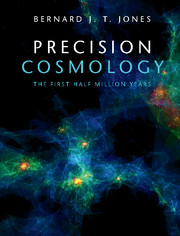Book contents
- Frontmatter
- Dedication
- Contents
- Preface
- Notation and Conventions
- Part I 100 Years of Cosmology
- Part II Newtonian Cosmology
- Part III Relativistic Cosmology
- Part IV The Physics of Matter and Radiation
- Part V Precision Tools for Precision Cosmology
- Appendix A SI, CGS and Planck Units
- Appendix B Magnitudes and Distances
- Appendix C Representing Vectors and Tensors
- Appendix D The Electromagnetic Field
- Appendix E Statistical Distributions
- Appendix F Functions on a Sphere
- Appendix G Acknowledgements
- References
- Index
Appendix B - Magnitudes and Distances
Published online by Cambridge University Press: 04 May 2017
- Frontmatter
- Dedication
- Contents
- Preface
- Notation and Conventions
- Part I 100 Years of Cosmology
- Part II Newtonian Cosmology
- Part III Relativistic Cosmology
- Part IV The Physics of Matter and Radiation
- Part V Precision Tools for Precision Cosmology
- Appendix A SI, CGS and Planck Units
- Appendix B Magnitudes and Distances
- Appendix C Representing Vectors and Tensors
- Appendix D The Electromagnetic Field
- Appendix E Statistical Distributions
- Appendix F Functions on a Sphere
- Appendix G Acknowledgements
- References
- Index
Summary
The distance to an astronomical source is a fundamental astronomical datum about the source. While astronomers measure sizes of objects in centimeters, meters or kilometers, distances to distant objects are measured in light years or parsecs. Large objects like galaxies and clusters of galaxies are also measured in light years or parsecs.
The light year is simply the distance travelled by light in one year and it is a fairly convenient unit of measure for the distances to stars. However, distances to stars are not measured using the travel time of light rays: nearby stellar distances are measured using parallax. The parallax is the maximum apparent angular shift in position of a star on the sky as the Earth goes from one side of its orbit to the other. This is the same as the angle subtended by the Earth's orbit as viewed from the star.
The parsec is the distance at which the parallax of an object would be 1 arc second. The parallax of the nearest star, 4.2 light years away, is 0.772 arcsec. The relationship between light years and parsecs is 1 parsec = 3.26 light years. Distances to cosmological objects are to be measured in Megaparsecs (Mpc).
Because of the curvature of space the distance as measured by parallax is not the same as the distances measured by brightness, or by diameter.
Magnitudes and all that
It is difficult to avoid discussing the apparent brightness of objects such as stars and galaxies without encountering one of astronomy's major idiosyncrasies – the magnitude scale. Ever since the time of Hipparchus of Niacea (c190BC–120BC), the brightnesses of stars have been measured relative to one another on a logarithmic scale. Around 150BC, Hipparchus had classified the brightest stars he could see as being of ‘magnitude 1’ and the faintest as being of ‘magnitude 6’: a change of 5 magnitudes represented a factor of 100 in brightness. Because the brain perceives increments in brightness logarithmically, each increment of 1 magnitude corresponded to a change in brightness by a factor of 10⅕ = 2.512.
The magnitude scale, as we know it today, was introduced by Pogson (1856). Nowadays we might decide to base a logarithmic brightness scale on powers of two, so that each ‘magnitude’ was twice as bright as its predecessor.
- Type
- Chapter
- Information
- Precision CosmologyThe First Half Million Years, pp. 679 - 681Publisher: Cambridge University PressPrint publication year: 2017



